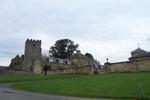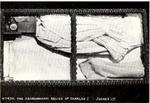Ashburnham Place and church
The oldest part of the existing house is the cellars which date back to the 15th century. The house was rebuilt after 1665 by John Ashburnham (1603-1671), with the Second Earl Ashburnham (1724-1812) adding a new suite of rooms to the front of the building in brick covered with cement stucco in the Gothic Revival style. The Third Earl (1760-1830) subsequently had the House refaced with stone slabs with turrets and minarets being added to the roof line. With another change in taste, the Fourth Earl (1797-1878) refaced the House in the brick still evident today.
In 1767 the Second Earl commissioned Capability Brown to landscape the grounds around the House. The implementation of Brown's designs, including the creation of three lakes, took from 1767 to 1781.
In 1953 the Estate was inherited by Rev. John Bickersteth, a distant cousin. Death duties of £427,000 were assessed on Lady Catherine's estate, over £7m at today's prices, which necessitated the sale of nearly all of the art and antiques and half the land and investments. In addition the House was afflicted with serious dry rot, with little in the way of funds to repair it. The only option was to demolish most of the House, and, in 1959, the central section lost its upper floor and the rest of the house was reduced to a single storey, with the extensive servants' wing at the back, the clock tower and the water tower being completely removed.
St Peter's church was originally built in the 14th Century, but in 1665 was totally rebuilt, except for the tower, by John Ashburnham. Prior to 1667 it was dedicated to St Mary the Virgin.
Ashburnham Archives
There is a vast amount of information kept at the East Sussex Record Office pertaining to the Ashburnham family and estate. A few bits are shown below. The catalogue can be viewed on the National Archives' Access to Archives website (http://www.nationalarchives.gov.uk/a2a/)
From ‘Farmer Labour and Team Journal’ Ashburnham Estate accounts book (ASH/2014)
Garden labourers:
“For wasps caught up to the 21st of June 1896 at 1d each
James Payne 2 ½ doz 2/6
Albert Davis 7 doz 7/-
James Harmer 5 doz 5/-
Henry Ransome 5 doz & 10 5/10
Frank Morris 4 doz 4/-
Fred Hobden 1 doz 1/-
David Taylor 4 doz 4/-
Charles Harmer 5 doz 5/-
Levi Winchester 5 doz 5/-
George Roberts 2 doz 2/-
Total £2.1.4 ”
Ashburnham Family Archive ref: ASH/3414
A list of poor persons who are having Copper Broth from the House July 10th 1878
Names
Residence Remarks
Beeny, Edgar Forge has a cow kept
Creasey, George Brown Bread Street carter
Cramp, Moses Thornden
Foord, George Pigknowl carter
Haselden, John
ditto broth & milk
Howe, Mr Ninfield
Hobden, John Junr Furnace
Hobden, John Senr Megshole
Hutchison, Mrs Pontsgreen
Isted, Thomas Pound Gate broth & milk
Isted, James Forge
Isted, James Brays Hill
Keeley, James Pontsgreen
Champion, George Thornden broth & milk
Scotcher, Stephen Linghams
ditto
Veness, Thomas Thornden accruing to children
Vidler, James Linghams
Winchester, S Creep Lodge
Winchester, Mrs Thornden
Winchester, Henry Junr Coomb Hill
Winchester, Mark Penhurst
Almshouse women broth & milk
Mrs Sutton Old Kennels milk
Mrs Hobday
Furnace ditto
Horace Creasy Ninfield ditto for twins
Mrs S Winchester Creep Lodge nourishment from House
Mrs Maxton
Nursery ditto
Mrs Hunnisett Ninfield
ditto
Mrs Mitchell Burnt Barnes ditto & wine
Ashburnham Family Archive ref:ASH/2611
Ashburnham Place Servants as at December 1881
Mrs Cornwell cook & housekeeper £60pa
Emma Crawford 2nd housemaid £16pa
Jane Thomas 3rd housemaid £12pa
Harriet Anderson stillroom maid £21pa
Mary Ann Beckett kitchen maid £16pa
Susan Tester scullery maid £9pa
Emma Tester dairy maid £20pa
Elizabeth Martin 1st laundry maid £21pa
Edith Wyeth 2nd laundry maid £12pa
Edward Hodgson clerk £10pa
Edwin Jones house steward £85pa
Alfred Moore 1st footman £32pa
Henry Mepham 2nd footman £28pa
George Slatter hall boy £15pa
William Parrott coachman £40pa
Henry Davies groom £35pa
Ashburnham Family Archive ref:ASH/2604
Ashburnham Place Servants as at July 1810
Phills Hodgson Ann Ridley
Elizb Darcy
Nathl Jones Thos Mytton Walter Maltman
Thos Jewell Joseph Carpenter Geo Young
Robt Barnsby Henry Edwards Willm Stewart
Chas Stewart Jas Harlot David Davies
Fred Arnold Maria Hookes
Mary Stephenson
Elizabh Rookes Ruth Watson Mary Bird
Sarah Crookford Elizth Badwell Elizth Watkins
STRUGGLE WITH THE BURGLARS
—
TWO MEN SHOT AT.
—
The alarmed inmates of the house immediately despatched a messenger, in all haste, on horseback, to Supt. Jenner, at the police-station at Battle, and also for a doctor. Mr. Davidson, the medical officer, and Mr. Jenner arrived almost simultaneously, the man's wounds being attended to by the former. The latter, in company with Sergt Coppard, immediately searched the vicinity of the house, but on account of the immense forest land with-which the place is surrounded, and the small although well-trained number of police in the district, no trace of the robbers could be found. Telegrams were sent off to all parts of the country, and a strict look-out kept at Battle, towards which place the burglars were supposed to have gone. Nothing, however, was to be seen of them.
The superintendent, on examining the window, which had been broken, found the glass had been smashed by the fist being put through. The catch had been unfastened, and the sash thrown up. It was immediately conjectured that the damage had not been committed by an experienced hand, or the glass would have been cut, as a precaution to preventing the members of the household, who, of course, were about, appearing upon the breaking of the glass. There were also a number of blood stains on the frame-work, showing that the men must have cut their hands, or some part of their person, in the course of the execution of their work.
On examining the grounds no footprints were to be seen, the hardness of the ground and the greensward acting as a preventive to this. The burglars, although not systematic in the breaking of the window, appeared to be so as regards the footmarks as above-mentioned, for about fifty yards from the building Sergt Coppard picked up a piece of ordinary packing-box wood, to which were attached two pieces of string, with which to attach it to the boot. This being placed at the bottom of the foot, was like a skate, and had the ground been soft or clammy, would have left the mark of a board only. A similar invention was found on the other side of the wall, so it is expected that, as the thieves were running away, the string broke and the " novelties" dropped off. The roads leading from the house were also inspected, as had the thieves not followed this they would on one side have had to cross a river, and on the other a lake. They must, therefore, till they passed the bridges, have kept in the middle of the road.
Up to this time, as far as can be gathered, they did not come into contact with any person, but about three hundred yards from the house, and a short distance past the "stone" bridge, a young man named William Gates, a gardener, in the employ of Sir Thomas Brassey, MP, at Normanhurst Court was proceeding up the road, when he heard footsteps approaching rather quickly. Thinking something was the matter he concealed himself in the hedge, running parallel with the road, but the burglars must have seen him, for as they passed about twelve yards from him, one of them fired a revolver. The shot did not strike him, as the night was dark, and the target was not phosphorescent. This served to alarm the young man, and remembering that two to one is not very pleasant, he did not follow, but immediately hurried to the house where he learnt the particulars before stated. To place the matter explicably before the public occupies a considerable amount of space, but the time occupied in the occurrence of all the facts as related above was the work of a very few minutes.
It is supposed by some that the burglars visited the house on the occasion of the Sussex Archaeological Society's visit, a month or two since, but we are inclined to differ from this suggestion, as had they made a survey of the windows through which they tried to enter, they would have seen that after opening them, they would meet with an obstruction in the shape of shutters about two inches in thickness, and not manufactured out of "matchboard." Behind these also are several iron bars, which the burglars could not have unfastened. Had they displaced any of the panels they could not have got through as they measure about 18ft by 8ft. To have made a hole large enough to admit them would have occupied a longer time than the men, we are persuaded, would have felt inclined to give to it, for fear of being disturbed in their work. As, we have before said, "the enterprising burglars" did not go to work in a manner that would have shown them to be adepts at the work. It cannot be yet discovered how long the men had been at their work, but, judging from the state of the window, they had only just commenced operations when the footman put in an appearance.
On the visit of the Archaeological Society, plans of the building were circulated, and the men may have got hold of one, but it not being a “criminal” one, it could not suit them, not giving all the shutters and other obstructions, or probably they would have deferred their visit to the place. It cannot either be conceived on what articles the thieves had designs, unless it be a large painting by Rembrandt, entitled "The Mathematician and his Scholar" which, of course, is very valuable. All round the room are book cases of polished walnut wood containing manuscripts entirely, many of which are said to be of immense value; but, should they have designed on any particular book, it would have taken any person unacquainted with the place a long time to discover it.
A watchman comes on duty at nine for the night, and the burglars, perhaps being aware of this, took advantage when most of the servants would be gathered together in other parts of the house. Had not the burglars been surprised, Mr. Jones, the house steward, would, a few minutes afterwards, have been taking his usual rounds to see all was safe, and no doubt he would then have encountered them.
Mr. Turner, a baker living in High-street, Battle, was returning home along the Boreham-road, and when near Ashburnham he saw a man about six feet in height, about 30 years of age, dressed in dark clothes and wearing a felt hat. He said "Good night” to the man, who, without answering, turned his back to him and looked towards the park. Shortly after he heard the report of a pistol. He did not see the man again.
It is believed that more than two men were engaged in the robbery. The Earl of Ashburnham was away at the time in London. We cannot conclude without complimenting the police on their prompt action in the matter, and the attention paid to all petty matters that crop up.



























































































